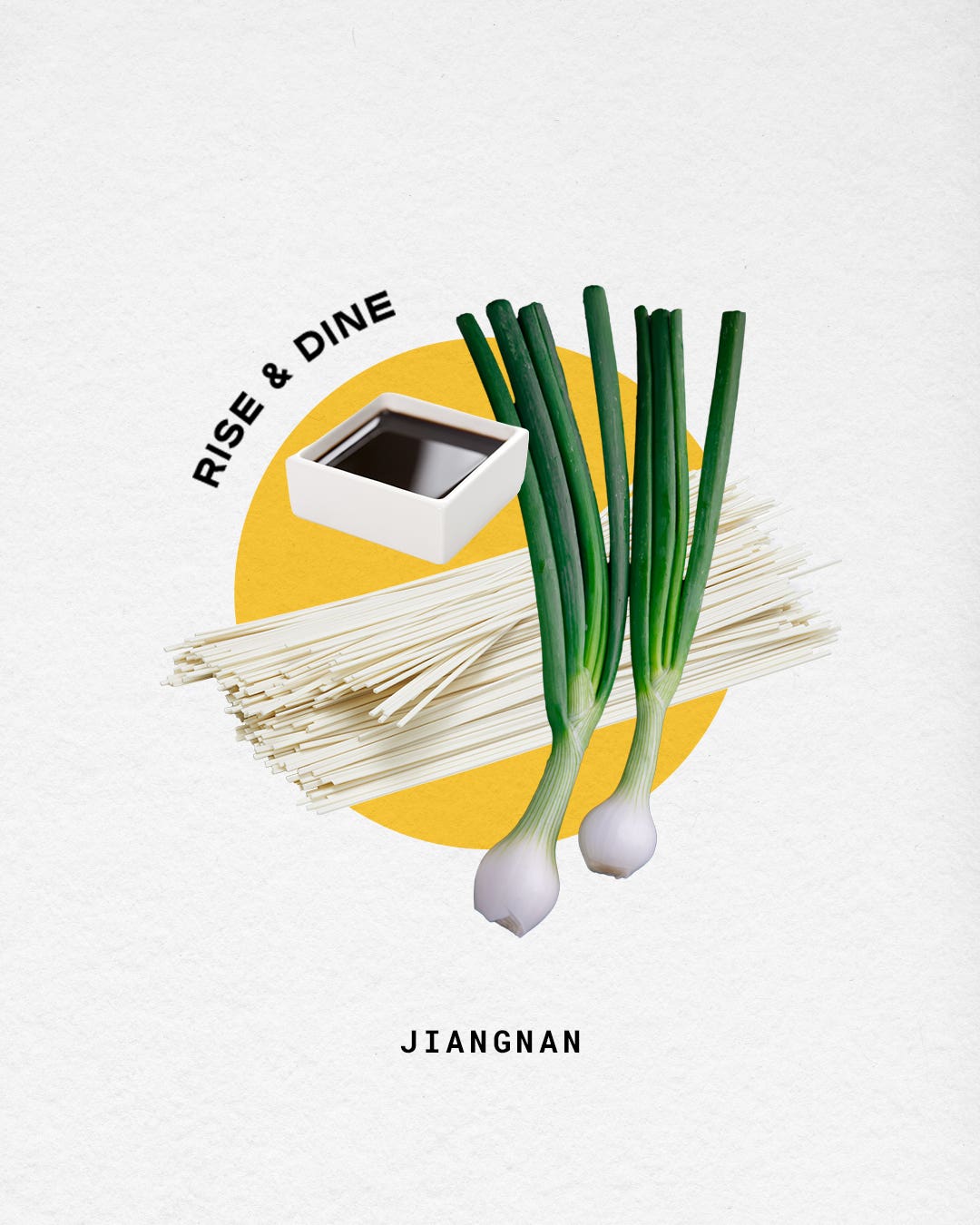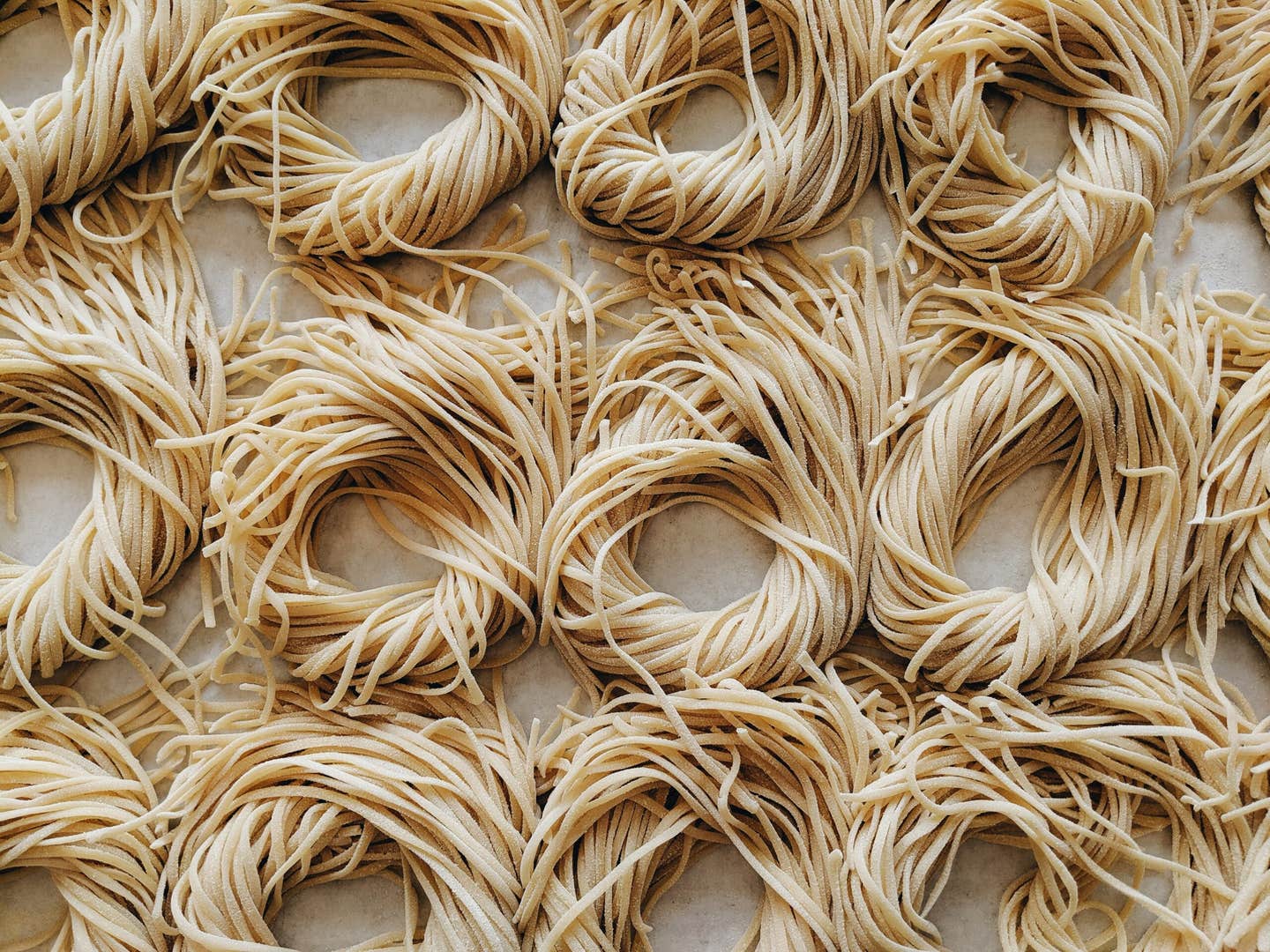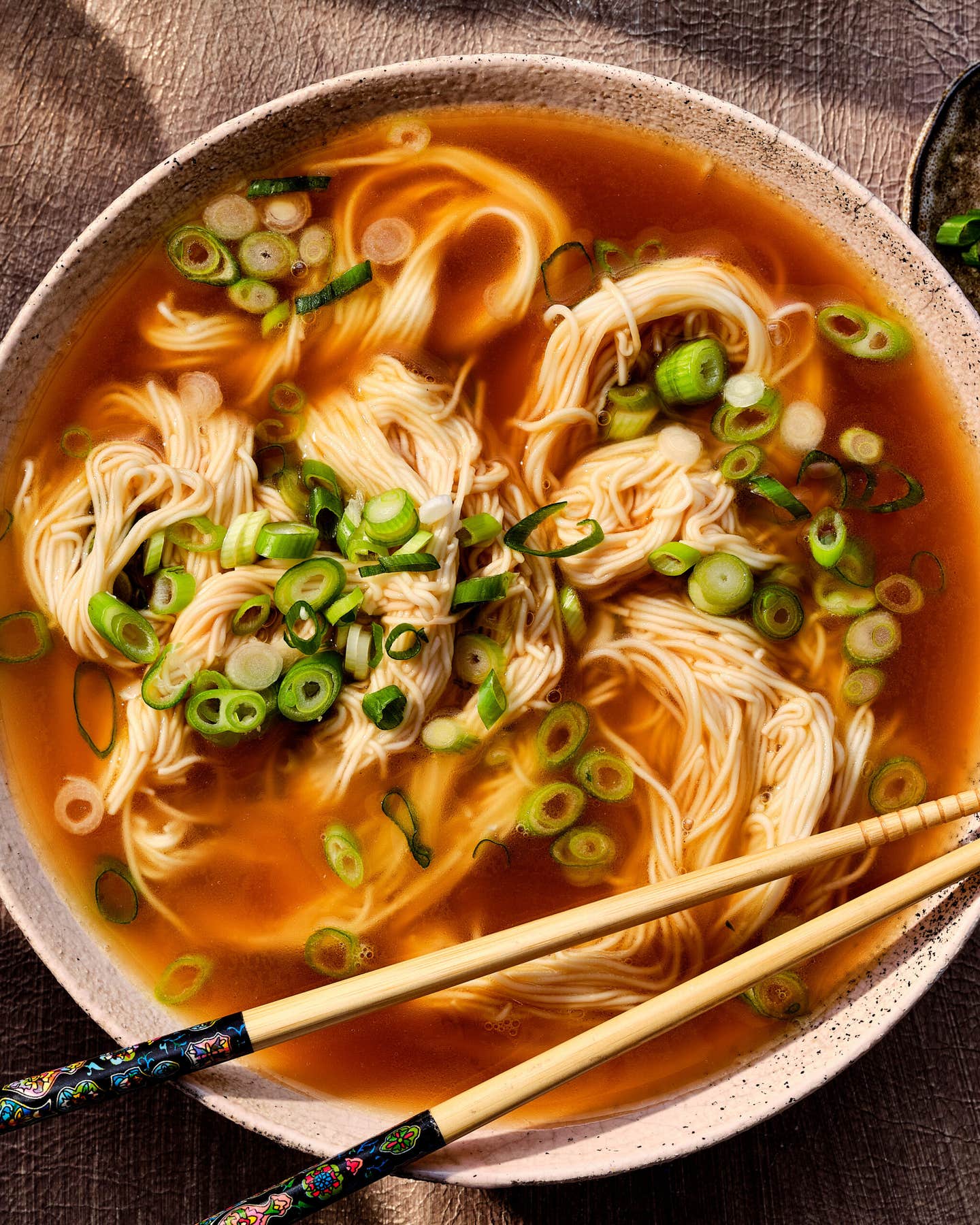I Make These Breakfast Noodles When I Want to Transport to My Ancestral Homeland
This dish taught me lard is the gift that keeps on giving.

Rise & Dine is a SAVEUR column by Senior Editor Megan Zhang, an aspiring early riser who seeks to explore the culture of mornings and rituals of breakfast around the world.
While visiting my grandmother in Jiaxing, the city in Eastern China’s Zhejiang Province where my mom grew up, I walked into the kitchen to find my uncle scraping the fat from the red-braised pork belly left over from the previous evening. The collagen-rich sauce was now solidified and jelly-like after its overnight stay in the fridge, a milky-white layer of fat covering the surface like ice atop a frozen lake.
I was still in college at the time and had just begun to take a greater interest in cooking, so I watched curiously as he coaxed the spoon around chunks of meat suspended in the gelatinous mixture, then deposited the fat into four soup bowls.
That wasn’t where I’d expected the fat to go. Growing up in the U.S., I’d witnessed on many occasions my aunties and uncles skimming the lard from pork braises and discarding it—to minimize caloric density, I guessed, or stave off blood clots. (Fat was America’s most vilified macronutrient in the 2000s, after all.) I asked my uncle if he didn’t plan to do the same. He gaped at me with an expression between bewilderment and horror. The thought of tossing out all that concentrated flavor was, as he put it, “fù zhū dōng liú,” a turn of phrase describing hard-earned achievements washing away and going to waste. (He loves using Chinese idioms dramatically.)
I followed my uncle around the kitchen as he heated up homemade broth on the stove, then boiled water in another pot to make noodles. As the two vessels bubbled away, he swiftly chopped scallions and deposited seasonings like soy sauce and MSG into each serving bowl. Minutes later, he handed me a portion of steaming yang chun mian (mian means noodles).

I spooned some broth into my mouth, expecting it to be unctuous from the fat. On the contrary, the taste was light and delicate, yet full-bodied and savory. The scallions chimed in with bursts of pepperiness, and the springy noodles (long xu mian, or “dragon whiskers” noodles, so named for their thinness) had a satisfying chew. I couldn’t believe how seemingly quick and simple the process had been, or how a mere handful of ingredients could conspire to create such balanced, complex flavor.
Chinese people have long esteemed the coastal Jiangnan region—whose name translates as “south of the Yangtze River”—as yú mǐ zhī xiāng, or land of fish and rice. The area includes the buzzy metropolis of Shanghai and nearby cities like Jiaxing, Hangzhou, Nanjing, Shaoxing, and Zhenjiang, where abundant waterways supply the local communities with bountiful aquatic fare, as well as fertile terrain for produce. The region's delicate, understated dishes allow the flavors of its mainstay ingredients—from seasonal greens and freshwater crabs, to preserved foods like Shaoxing wine and Jinhua ham—to shine, explains Fuchsia Dunlop, author of the cookbook Land of Fish and Rice. “It’s about using seasoning lightly,” adds Lillian Luk, who was born and raised in Shanghai and now runs the pop-up Shanghai Supper Club in London. “You’re [only] trying to coax out whatever the ingredient’s unique taste is.”
Jiangnan cooks have applied that philosophy broadly, even to initially foreign ingredients. According to Miranda Brown, professor of Chinese studies at the University of Michigan, when the capital moved south to Hangzhou during the Southern Song Dynasty (1127 - 1279), it prompted an influx of northern wheat-based delicacies like dumplings, spring rolls, and noodles. Over time, dishes that fused those concepts with the subtle seasoning styles of the south proliferated in the region. With its frugal, humble ingredients, yang chun noodles evolved into a popular breakfast item—as easy to make as it is quick and comforting to slurp down.
After that breakfast my uncle whipped up, I began seeing yang chun noodles everywhere I went in Jiangnan. Noodle vendors hawked it from street-side stalls, behind scribbled signage advertising a bowl for just 10 yuan (less than two U.S. dollars). Teenagers slurped it from plastic to-go containers while perched on the steps of their school. And there it was on the menu at Nanjing Impressions, an iconic national restaurant chain serving Nanjing specialties. It must have been the frequency illusion at work, waking me up to the ubiquity of this regional mainstay.

“If you ask Shanghainese people what they grew up eating [for breakfast], most people would think of yang chun noodles,” Luk surmises. My cousin Alex, who grew up near Nanjing and now studies in London, seconds this; whenever he misses home, the dish is “one of my go-to choices,” he tells me. Though yang chun noodles can cure homesickness any time of year, there may be no better time to enjoy the meal than spring. My uncle explains that the dish’s name likely derives from the term xiǎo yáng chūn (roughly, “little spring”): it’s a moniker for the tenth lunar month, when the weather tends to be balmy and spring-like despite it being autumn. Springtime also happens to be when green onions, which Luk considers an indispensable “magic ingredient in Chinese cooking,” are at their peak flavor. After the heaviness of winter’s rich meats and stews, a refreshing soup is the perfect palate cleanser to welcome a new season.
It’s been several years since my uncle made me wise to the gifts of lard. Since then, I’ve made this breakfast repeatedly, usually the morning after cooking some porky braise. The smell of the savory lard, salty soy sauce, and garlicky onions swirling together always transports me back to my ancestral homeland. I’ve also experimented with incorporating different textures into the dish over the years, adding toppings like blanched bok choy, rehydrated dried shiitake mushrooms, or soy sauce eggs. However, the beauty of this dish—what makes it emblematic of Jiangnan’s delicate, subtle style—is its pure simplicity. As my idiom-loving uncle might say, it’s best not to “huà shé tiān zú,” or draw feet onto a painting of a snake. The dish, like the reptile, is already complete.
RECIPE

Keep Reading
Continue to Next Story










